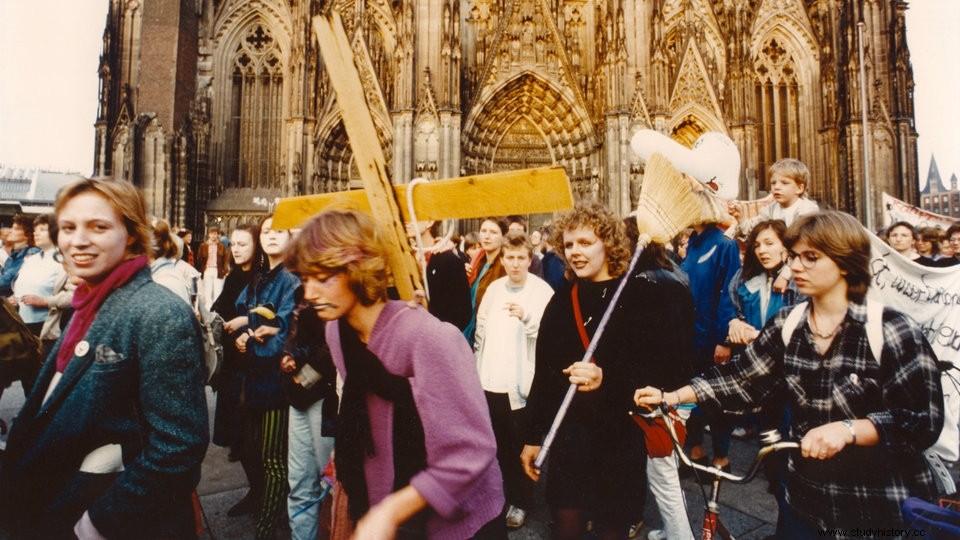"We are the Women's Liberation Front!" shouted rebellious women from New York to Berlin in the 1970s. They were fed up with being patronized by men. They wanted to take their lives into their own hands and fought for equality between women and men.
The master of the house
In 1949, the Social Democratic MP Elisabeth Selbert pushed through for equal rights to be included in the Basic Law of the Federal Republic of Germany. Article 3 therefore reads:"Men and women have equal rights".
However, the reality was different in the 1950s and 1960s. An illegitimate child was a social catastrophe for the woman, many mothers were not even given custody. Marriage and family law made the man the sole ruler over his wife and children.
A wife had to be sexually available to her husband at all times. If he abused her or the children, it was considered a private matter. According to the law, married women were only allowed to work if their work was "compatible with their duties in marriage and family".
The so-called "low-wage groups" still existed in the 1970s. And even if a woman did the same work as a man, she often received significantly less money for it.
Burning bras
The so-called first wave of the women's movement emerged in the United States in the mid-19th century and fought, among other things, for women's suffrage. The second wave began in the 1960s – in many places at the same time.
In the USA Betty Friedan wrote her bestseller "Der Femininity Wahn" in 1963, in which she settled accounts with the typical role of women. In France, Simone de Beauvoir wrote "The Second Sex" in 1949, which countless women around the world made their Bible.
The philosopher and writer explained in this book:"One is not born a woman, one is made to be one". And he meant:women are not by nature submissive, dependent and helpless. They're just raised to do it from a young age. But they can also be different. This encouraged young women in the late 1960s.
Soon women declared publicly:"We now decide for ourselves how we want to live, love and look!" In the United States, feminist activists publicly burned their brassieres (bras). In Amsterdam, the "Dollen Minnas" pinched the men's buttocks. And in Rome, women sang at a demonstration:"Tremate, tremate, le streghe son tornate!" ("Tremble, tremble, the witches have returned!").

Women demonstrated against male violence on Walpurgis Night
Flying tomatoes
The female students who were active in the "Socialist German Student Union" (SDS) found that the Marxist theory they devoured so enthusiastically came almost exclusively from men - and women did not appear in it. They were angry that their comrades wanted to liberate all the peoples of the world, but not their own companions. Because the 1968 revolutionaries also wanted women who would do their laundry, type the leaflets and look as attractive as possible.
In September 1968 the national congress of the SDS met in Frankfurt. And once again the comrades didn't want to hear what the women had to say. The Berlin delegate Sigrid Rüger took three tomatoes out of her bag and threw them towards the podium. Two of them hit - and slapped one of the "comrades in chief" in the face.
"My belly is mine"
At the beginning of the 1970s, women's groups and women's centers were established from Kiel to Constance. They all took up the fight against paragraph 218, the abortion paragraph. At that time, abortion was forbidden, it had to be carried out in secret, it was expensive, humiliating and sometimes life-threatening.
Men decided whether a woman should have a child or not. But the women's movement said:Neither judges nor doctors, let alone theologians, have the right to rule over a woman's body and life. And they demanded:Paragraph 218 must be deleted without replacement.
In 1974, paragraph 218 was revised based on the indication model, which allowed abortion for certain medical, social or ethical reasons. The deadline solution has been in force since 1995, which allows termination in the first three months of pregnancy if counseling has taken place beforehand.

1992:Demo for the abolition of Section 218
The woman is herself
It was not far from dealing with abortion and pregnancy to dealing with the topics of marriage, motherhood and sexuality. The women found that they knew very little about their own bodies.
They asked themselves, "How do we treat ourselves and what do we do to ourselves? What is beauty? What are our own needs and when do we only meet men's?"
And the new women's movement was not limited to talking and demanding. She also took action herself. When the feminists found out how many women were abused by their husbands, they created "houses for beaten women", or "women's shelters" for short. They set up emergency numbers where rape victims could get help.
And they made sure that sexual abuse of girls (and boys) was no longer condoned. They founded publishing houses, bookstores, newspapers, archives and health centers. They held exhibitions, concerts, film festivals. Many of these projects and initiatives still exist today.

1976:The "Art and Literature Meeting for Women" in Frankfurt-Sachsenhausen
The Achievements
The women's movement has achieved a lot. Women have better career opportunities than they did 50 years ago. They are legally equal to men in all areas. An illegitimate child is no longer a shame. Divorces no longer throw women into existential difficulties.
Husbands who hit their wives and children have to leave the house if the wife wants it. Marital rape is no longer legal. In children's books (and in real life) girls are often brave, smart and quite cheeky. There are female pastors and museum directors, pilots and chief physicians, carpenters and web designers.
